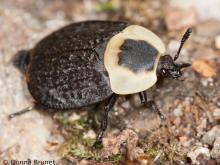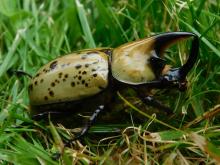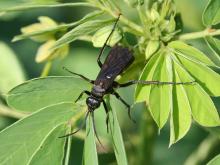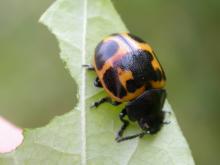Land Invertebrates
Media

Species Types
Scientific Name
Promachus vertebratus
Description
The green robber fly is one of several species of robber flies called giant robber flies or bee killers. They are indeed large, with distinctive yellow and dark stripes on the abdomen and iridescent green eyes.
Media

Species Types
Scientific Name
Milesia virginiensis
Description
The yellowjacket hover fly, or Virginia flower fly, is a completely harmless mimic of yellowjackets. No more dangerous than a housefly, it buzzes around and seems aggressive.
Media

Species Types
Scientific Name
Necrophila americana
Description
The American carrion beetle has a yellow pronotum with a big black spot in the middle. Adults of this species of silphid beetle eat fly maggots, plus some carrion. In flight, they seem like bumblebees.
Media

Species Types
Scientific Name
Phanaeus vindex
Description
Although most dung beetles are dull black, the rainbow scarab is bright metallic green and copper.
Media

Species Types
Scientific Name
About 28 species in North America
Description
Horntails look a lot like wasps but have a taillike spine that projects from the tip of the abdomen. Their cylindrical bodies also lack the narrow waist so common in wasps.
Media

Species Types
Scientific Name
Dynastes tityus
Description
The eastern Hercules beetle is a breathtaking animal. Like its Greek-hero namesake, it is big and strong. Males have horns; females do not. Hercules beetles are harmless to people.
Media

Species Types
Scientific Name
Anoplius spp.
Description
There are nearly 50 North American species of blue-black spider wasps. Many in this genus are entirely black, with a bluish sheen, while many others have an orange marking on the abdomen.
Media

Species Types
Scientific Name
Psorthaspis spp.
Description
Spider wasps in genus Psorthaspis look quite a lot like velvet ants. There are several species. The ones in our area are usually red and black, just like the coloration of the velvet ants in our region.
Media

Species Types
Scientific Name
Tetraopes spp.
Description
Milkweed longhorns are a genus of longhorned beetles that feed on milkweed. They are red with black spots. The species are very similar.
Media

Species Types
Scientific Name
Labidomera clivicollis
Description
The swamp milkweed leaf beetle is found on the various milkweeds it eats, often in grassy areas or on roadsides. The exact pattern of orange and black varies among individuals.
See Also



Media

Species Types
Scientific Name
Cisseps fulvicollis
Description
The yellow-collared scape moth is more often “orange-collared.” And whether you think it looks more like a firefly or a wasp, it’s still a moth!
Media

Species Types
Scientific Name
Nearly 150 species in North America north of Mexico
Description
Slim, delicate plume moths are instantly recognizable by their T-shaped silhouette, long legs, and muted shades of tan and brown. It can be hard to separate the various species.
Media

Species Types
Scientific Name
Pyrrharctia isabella
Description
Not many people know the adult Isabella tiger moth when they see one, but we’re all acquainted with its caterpillar, the woolly worm, or woolly bear.
About Land Invertebrates in Missouri
Invertebrates are animals without backbones, including earthworms, slugs, snails, and arthropods. Arthropods—invertebrates with “jointed legs” — are a group of invertebrates that includes crayfish, shrimp, millipedes, centipedes, mites, spiders, and insects. There may be as many as 10 million species of insects alive on earth today, and they probably constitute more than 90 percent all animal species.





















